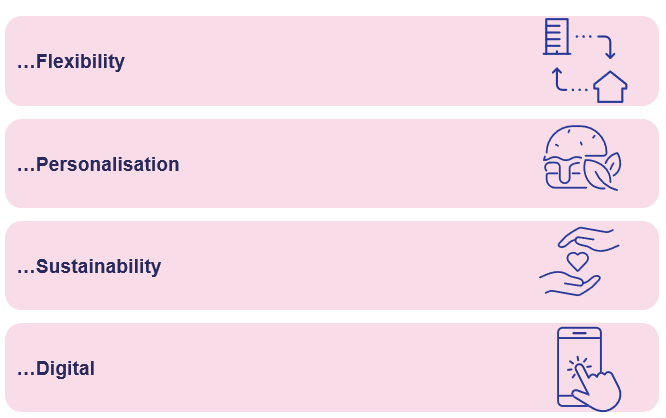This week Julie Ennis, CEO of Sodexo Corporate Services UK&I and Country President Ireland delivered a keynote speech at a leading industry event on what the future has in store for the food sector. In this first of two blog posts, she summarises her thoughts, findings and what trends we are seeing globally across Sodexo. In her second instalment she will explore what these trends mean here in the UK and Ireland.
Following Covid, food didn’t change overnight. In some areas, the pandemic just consolidated trends we’d been tracking for some time. However, the way we work did change overnight and very rapidly.
The ‘where’ of it all changed, because suddenly we were at home trying to blur our background on Teams. ‘How’ changed, with food service in particular, dealing with a whole new level of safety controls.
The ‘why’ changed too, as people looked for meaning in their work, and got choosier not just about roles, but also about companies. And the ‘what’ changed too – sometimes drastically – as tens of thousands of people all over the world made head-spinning career switches.
What first drew me to Sodexo was the sheer scale of its impact. 45 countries, 27,000 sites, more than 400,000 colleagues and serving 80 million guests daily. It’s a place where all the everyday things we do – a great coffee, a relaxing space, a meal that hits the spot – add up to so much more than the sum of their parts.
Sodexo’s global scale is actually a good place to start in terms of the trends we’re seeing now, in what will forever be known as “the post-Covid times.” We have a continuous programme of consumer research, both quantitative and qualitative, and we also get to sense-check what the research is telling us on the ground. When something changes in China, for example, we can see whether it’s new or an extension of an existing development that will soon arrive here.
The main trends we’re seeing relate to flexibility, personalisation, sustainability and digital. 
Starting with flexibility, the obvious change is to our working week, which seems to have settled on a global average of around two days spent at home. The UK got there quite quickly, France took longer, and the US was actually on its way to that already. But home working has grown everywhere, even in Asia where it was extremely rare before.
The other aspect to flexibility is not where people eat, but the way they eat. If you’re anything like me, when you work at home, you don’t have a ‘lunchtime’. My lunch has to fit around my work and not the other way around. In corporate offices, which is my world, the concept of the lunch hour has all but disappeared. People want to eat in the way that works for them. They don’t want a company to dictate a time when they can be hungry.
This growing desire for flexibility reflects a simple change in the way we live. Even in relatively captive markets, like a hospital, for example, or a university, you can visit the café in its 12-to-2 window or get Uber eats to deliver what you want when you want it. The ‘extended choice’ side of flexibility is intrinsically linked to the next trend, and that’s personalisation.
This is a funny one really, because we’re in this strange situation where we know, categorically, what every single consumer around the world wants. Other sectors can only dream of such insight.
But the tricky bit is that what everyone wants is choices that work only for them.
They want food that matches their lifestyle, mood, their diary and their health.
Vegetarians want a choice of vegetarian meals, not a meal with just the meat left off. As someone who loves their food, but is also coeliac, personalisation is a trend I can relate to. Because I want to actively choose a dish, not arrive at it by a process of elimination.
What constitutes a healthy choice is evolving too. Being presented with one dish that’s 1,500 calories and another that’s only 400 but is made up of leaves and some sauce isn’t a genuine choice. People want to decide between equally delicious meals with just the right amount of protein to stop them staring through the window of the vending machine at 3pm.
The third trend is sustainability. That’s broader than it sounds, because if you’re talking just in terms of environmental footprint, that ship has sailed. In the narrow sense, sustainability is not so much a trend as a bare minimum.
Sustainability as we conceive it extends beyond ‘planet’ and into ‘places’ and ‘people’ too. More and more, we’re seeing consumers value local provenance, heritage and local and social impact. Globally, we’re also seeing growing concern among businesses – not just policy makers – that healthy food options may only be available to certain socio-economic groups.
And of course here, over the 10 years we’ve been partnering with the redistribution charity FareShare, we’ve seen food insecurity rise to record levels.
The final trend is digital. And that includes how we, our clients and our guests use the digital world. It’s a marketing truism that the more you understand about your customers’ problems, the better your solution will be, and it’s why our ambition is to exponentially grow our active global digital consumers by 2025.
Digital is an enabler of the other three trends, and technologies like AI could have the potential to change them all, but it’s also key to identifying the next big thing in the future.
So, there are our four global food trends – flexibility, personalisation, sustainability and digital. In my next blog post I will examine what they mean for businesses today in the UK&I.

